“Revenge is a dish best served cold”. This much quotes phrase first appeared in the mid 18 century, a few years before Giuseppe Verdi wrote Il Trovatore. Though this beloved opera ends with an act of revenge that was declared many years earlier, there is nothing cold about it. In the 1853 opera revenge take a horrible toll on the avenger. Il Trovatore, considered one of the greatest of operas, is a boiling soup of passion, jealousy and rage, in which the characters are haunted by their past, and their arias are filled with blood and fire.
This metaphoric fire is often represented by real fire burning on the stage in Daniele Abbado’s production of Il Trovatore at the Israeli Opera. For Verdi, “the enemy is inside of us” says Abbado. Even more effective is the suggestive lighting designed by Alessandro Carletti. When a chorus of fired up men call for vengeance in the opening act, they are washed with red light, symbolizing the blood in their eyes. Later those men will get ready to attack a fortress while carrying black flags and singing about the fortunes they hope to find there, but the harsh white light on their faces gives them the appearance of corpses.
The highly melodramatic plot is not a particularly good one, but Verdi filled it with many of his best loved arias and duets. Count Di Luna lusts after Leonora, who is in love with the troubadour Manrico. The jealous count wants to kill his rival, not knowing that he is his long lost brother. When he was a baby Manrico was abducted by the gypsy Azucena who intended to avenge her mother’s wrongful accusation and execution. And that’s just the beginning.
Originally taking place during the Peninsular War in 19th century Spain, Abbado moved the story to the Spanish Civil War in the 1930s. “Both sides refer to the same culture, Latin and Catholic,” Abbado said to the Jerusalem Post. “So on stage, you will see a very large Madonna that both parties want to control. Azucena and the other gypsies are a minority, they get in the way of that.”
This choice of a different era allows for lighter costumes, while still having a period look. The costumes are mostly black and white, with olive uniforms added in the second half. It is the lighting that adds color in certain dramatic moments. The sets, props and costumes were brought over from the 2017 production of the Wiener Staatsoper.
The production opens with a beautiful tableau of armed men arranged in a painterly composition. There are more gorgeous tableaux to come, but in between the stage is too empty, and the singers are too static. Only Azucena brings in dramatic movement, giving a thrilling portrait of PTSD as she describes her dead mother’s voice haunting her. Played with fire by Italian mezzo soprano Veronica Simeoni on opening night, she was the real star of the show. Impolite women have been accused by men of being witches throughout history. This misogynistic habit has become a major topic of discussion of the Me Too movement, and it’s possible Abbado was more interested in her character then in all the others.
In the role of Leonora, Italian soprano Marta Torbidoni presented a beautiful rich voice, but she only came alive as a character in the second half of the opera. When she arrived at Leonora’s famous love aria “D’amor sull’ali rosee”, begging di Luna for mercy and offering herself in place of her lover, Torbidoni gave it her all. Playing the title role, Leonardo Caimi’s tenor was not as impressive. His voice is quite beautiful, but he struggled with the higher notes. His acting was also lackluster. Baritone Sebastian Catana was more charismatic as the jealous count. The chorus conducted by Itay Berckovitch sung very well and conductor Giuliano Carella lead the orchestra with conviction. All in all it is a beautiful production with a few less inspired stretches that could have used more energy.

